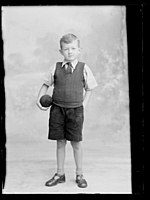T-bar sandal: Difference between revisions
wl toebox |
|||
| Line 10: | Line 10: | ||
First seen in Europe and America in the early 1900s, T-bars became very common among children in the 1950s,<ref>{{Cite book |title=Children's Clothes: Since 1750 |first=Clare |last=Rose |publisher=B. T. Batsford Limited |location=London |year=1989 |isbn=0-7134-5741-4 |oclc=19812913 |page=149 |url=https://books.google.com/books?ei=bZK2UYDdLI-84AOT24G4Bw&id=3NffAAAAMAAJ&q=t-bar#search_anchor |accessdate=10 June 2013}}</ref> particularly among boys where they supplanted pre-war [[Mary Jane (shoe)|Mary Janes]]. T-bar wearing declined after the 1960s nonetheless, following the cultural and clothing revolution that swept the West. |
First seen in Europe and America in the early 1900s, T-bars became very common among children in the 1950s,<ref>{{Cite book |title=Children's Clothes: Since 1750 |first=Clare |last=Rose |publisher=B. T. Batsford Limited |location=London |year=1989 |isbn=0-7134-5741-4 |oclc=19812913 |page=149 |url=https://books.google.com/books?ei=bZK2UYDdLI-84AOT24G4Bw&id=3NffAAAAMAAJ&q=t-bar#search_anchor |accessdate=10 June 2013}}</ref> particularly among boys where they supplanted pre-war [[Mary Jane (shoe)|Mary Janes]]. T-bar wearing declined after the 1960s nonetheless, following the cultural and clothing revolution that swept the West. |
||
Today, T-bars |
Today, T-bars are more associated with girls, particularly the more classic styles and are often considered semi-formal shoes, appropriate for school (some primary schools in the United Kingdom require that pupils wear them with their [[school uniform|uniform]]<ref>{{Cite web |title=Closed-toe Sandals |first= |last= |publisher=Historical Boys' Clothing |date=8 November 2006 |page=149 |url=http://histclo.com/Style/foot/sandal/sandal-ct.html |accessdate=10 June 2013}}</ref>). They may also be viewed as formal shoes for children, suitable for religious ceremonies, weddings, visits, and birthday parties for example. |
||
More modern styles are worn in casual settings, however: playgrounds, shopping centres, etc. Although less popular than in the past, T-bars remain a timeless classic of children's fashion and, for many people, a symbol of childhood. |
|||
==Gallery== |
==Gallery== |
||
Revision as of 02:58, 12 April 2021
This article needs additional citations for verification. (May 2009) |

A T-bar sandal or T-bar shoe (also known in the United Kingdom as "school sandal" or "closed-toe sandal") is a closed, low-cut shoe with two or more straps forming one or more T shapes (one or more straps across the instep passing through a perpendicular, central strap that extends from the vamp).
Classic T-bars for children are typically made of blue or brown leather, have two thin straps forming a single T shape and fastened with a buckle, a broad and rounded toebox pierced with a pattern of holes, a low heel, and a crêpe rubber outsole stitched-down to the upper. Among boys, T-bars are traditionally worn with socks (though it is possible without them as well), short trousers and a shirt.
History
First seen in Europe and America in the early 1900s, T-bars became very common among children in the 1950s,[1] particularly among boys where they supplanted pre-war Mary Janes. T-bar wearing declined after the 1960s nonetheless, following the cultural and clothing revolution that swept the West.
Today, T-bars are more associated with girls, particularly the more classic styles and are often considered semi-formal shoes, appropriate for school (some primary schools in the United Kingdom require that pupils wear them with their uniform[2]). They may also be viewed as formal shoes for children, suitable for religious ceremonies, weddings, visits, and birthday parties for example.
More modern styles are worn in casual settings, however: playgrounds, shopping centres, etc. Although less popular than in the past, T-bars remain a timeless classic of children's fashion and, for many people, a symbol of childhood.
Gallery
-
Two boys wearing twin-strap T-bar sandals in Venice, Italy. in 1907.
-
Studio photograph of a seven-year-old boy wearing T-bar sandals in Strabane, Northern Ireland, 1915.
-
A girl harpist wearing twin-strap T-bar sandals in Wales, 1960.
-
Studio photograph of boys wearing T-bar sandals in Colombo, Sri Lanka, 1964.
-
A Girl Guide and a Brownie wearing T-bar sandals in Canada, about 1975.
-
A four-year-old boy wearing a kilt and T-bar sandals in Scotland, 1987.
References
- ^ Rose, Clare (1989). Children's Clothes: Since 1750. London: B. T. Batsford Limited. p. 149. ISBN 0-7134-5741-4. OCLC 19812913. Retrieved 10 June 2013.
- ^ "Closed-toe Sandals". Historical Boys' Clothing. 8 November 2006. p. 149. Retrieved 10 June 2013.







